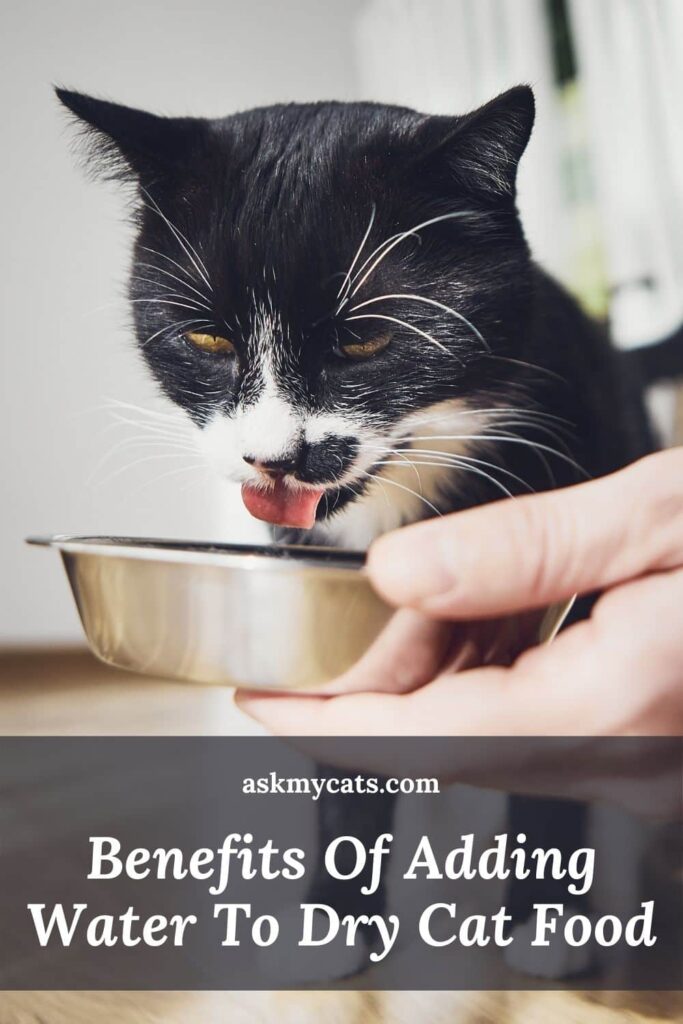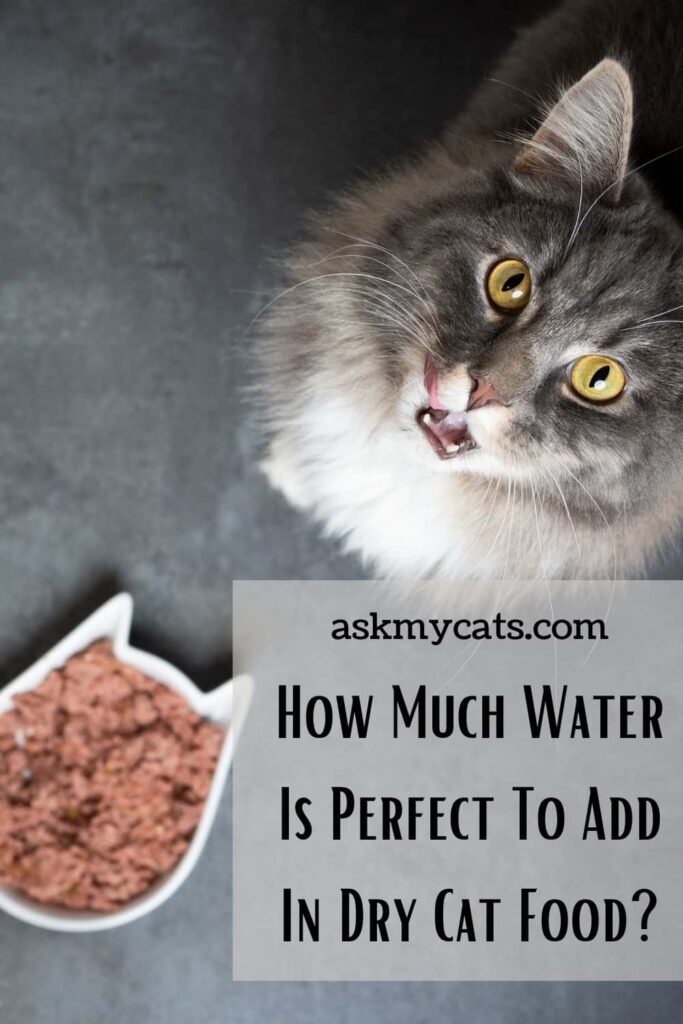Many of us are alert to what kind of food our dogs and cats eat, especially if they begin to lose interest. Fortunately, you may use a few tricks to revitalize animal food routines, including pet food blending.
Wet food is much costlier and less convenient to use, but it may be useful for cats that are vulnerable to inflammation of the urinary tract, constipation, and being overweight.
Dry food can be a very efficacious means of delivering calories to cats with limited food volume which encourages the use of food puzzles and food toy dispensers.


Give Your Cat the Perfect Day
Get the Free Ebook!
What Are The Benefits Of Adding Water To Dry Cat Food?

1. Give A Boost To The Daily Water Intake
I discussed previously that adding water to dry food can increase its daily intake of water.
Really, I want to reconsider this is one of the biggest advantages. This is one of the best ways to boost your intake.
The biggest advantage I claim is because of the dehydration-induced knock-on problems.
Take the following:
- Circulation of the blood
- Infections of the urinary tract (UTIs)
- Unbalances of electrolytes
This is just a limited sampling of possible dehydration-related problems.
This is a clear explanation for moisturizing dried cat food. You want to increase the consumption of water to get the intake as similar as possible to a cat in the wild. Maybe you are wondering why bother?
Ok, when the water intake falls below what the cat has developed over a thousand years, you get a whole bunch of lousy conditions that are healthy for your cat.
Dehydration, urinary crystals, and sluggish digestion are the typical issues with the lack of water in a cat’s diet.
2. Help In Digestion
The taste, for example, is one of the problems with dry cat food. It’s not digestible fast.
In fact, not all the parts in the mouth of your cat are chewed and digested properly. There will inevitably be parts that are eaten entirely which will create digestion problems.
Thus it can help to increase digestion by adding some water. These random parts are then minimized and can be eaten.
Are you too worried about why your cat never bites or scratches? Take a look here.
3. Stop Fast Eating
The pace that your pet can eat is one problem with a dry cat’s food, for example, kibble. Let’s be fair, she should practically suck it up quickly. You’re with me, like a storm that Lapps local waste?
The addition of a small quantity of water would therefore impact the texture and reduce your capacity; you are with me, to hover up the food as a benefit?
Quick feeding is a challenge since it always ends up vomiting your pet. You’re washing up too! There’s no problem besides that!
Not exactly, if the cat doesn’t feed well, it will lose weight or need more food, which means that the purchased bills have sprouted half the food.
You can go the way to make it harder for them to use puzzle feeders, sluggish cat bowls, or scheduled feeders for their food.
Otherwise, you should try to wind down the kibble and slow it down! It just costs less and a treat works.
4. Bloat Reduction
The cat will absorb the moisture of the stomach and spread when its dry food is consumed and the water reaches the wet stomach, the kibble.
The ultimate consequence is that your cat is swollen and thrown up.
But one fast way in which you try the kibble is to apply something water and to see if it develops in front of your eyes. That’s not happening in all dry kibbles.
If so, imagine how you’re doing when your cat eats it.
By adding water and extending this chicken you can decrease bloat and vomiting so that your cat is satisfied at the right time and then ceases overeating while it is feeding.
5. Mission Enhancing Appetite
Perhaps you don’t have a fast-eating or overeating problem? Perhaps you had the opposite problem. Your cat isn’t getting enough food.
The little bugger is simply uninterested. Are you concerned that the skinny wretch would vanish?
Consider giving it a shot. Fill the container halfway with water that isn’t too cold and that is barely wet. The result can be something more unique in terms of texture, taste, and aromas than your standard dried cardboard kibble.
Some cats are very picky and may refuse to eat something that is too dry, too rough, at the wrong temperature, or doesn’t smell good – and who can blame them?
Who wants a flavorless meal or fries are eaten cold? Chinese food that is too cold to eat…no thanks. Add water to the cat’s bowl to see how you can lure them.
Must Read: How Long Can A Cat Go Without Water?
How Much Water Is Perfect To Add In Dry Cat Food?

Normally, a cat consuming wet food gets a lot of moisture from the wet food.
The moisture content in most wet foods is about 80%, which is similar to the moisture content of a cat’s natural diet.
A cat that eats wet food can only need an extra 30 ml of water per day in addition to their wet food. Even on a wet food diet, they need access to safe, fresh water.
A cat eating dry kibble can need up to 200 ml of additional water to absorb the same amount of moisture as a cat eating wet food!
Add about 1/4 cup (60 ml) of water to each helping to increase a cat’s water intake, enhance the taste and scent of the food, and slow down eating while also making the food appealing.
This water should be wet, but not boiling, to bring out the best taste. The aim isn’t to make a broth, but to soak the kibble until it begins to fall apart and lose its shape.
Standard dry food guidance will be to give a 12-pound cat a third of a cup of kibble per day. You could serve this in three halves. So three-quarters of a cup per meal.
If you add 60 ml of water per meal, you’ll get a lot closer to a wet diet’s moisture content. However, you will find that it will never be the same as eating wet food.
If you use so much water, the food will simply disintegrate into a watery mess!
You might also like to read about how long does dry cat food last
Why Shouldn’t You Wet Your Kibble For Cat?

Unfortunately, the news isn’t all nice. There are a number of compelling arguments against wetting dried cat food.
The biggest problem is that bacteria and fungi will live in certain dry foods. You don’t have to be worried about their appearance because the food is dry.
When you wet food and leave it out for too long, particularly in warmer weather, bacteria and fungi will spread and bloom, causing health problems for your cat if the cat ingests too many of these pollutants.
What do I do? If you’re going to wet the kibble, don’t leave it out for longer than half an hour. The threats can be reduced in this manner.
But, you might argue, that defeats the purpose of dry food. You’d like your cat to eat dry food so that it can be left outside all day without being smelly. This is the issue of moistening dried food.
If you want your pet to have some moisture in their diet, this is not the right thing to feed them. The advantages of dry food come from the absence of moisture!
Another disadvantage to wetting dried cat food is that it makes a huge mess. I’m sure some people avoid feeding wet food because the leftovers are always foul-tasting, and washing the bowl is time-consuming if you don’t have a dishwasher.
Ok, you’ve got the same issue of moistened dried food. It dries to the bowl like stale cornflakes to concrete and is almost as difficult to clean up as stale wet food.
It’s all up to you. To increase the cat’s moisture intake, add water to dry cat food, but don’t leave it out for too long or in such a big amount that it spoils or transforms into concrete. Instead, bite the bullet and go to a wet food diet.
Do check for maggots in your cat’s food while mixing water!
Frequently Asked Questions
How much water should you add to dry cat food?
We recommend that you begin offering moistened dry food at 3 – 4 weeks old and make it available to kittens at all times through the weaning stage at 6 – 8 weeks old.
Moistening the food makes it easier for young kittens to chew and swallow. During this time, it is best to take the recommended daily amount of food and split it into several servings.
Can cats live on dry food?
Dry food is fine as long as it is complete and balanced. Dry food may be less expensive than canned cat food and may stay fresher longer. Cats that eat only dry food need to be provided with lots of fresh water, especially if they are prone to developing urinary tract blockages.
Can I mix wet and dry cat food?
Mixing wet and dry food makes it easier for you to manage the dietary and nutritional needs of your unique cat. Together with your veterinarian, it’s surprisingly easy to create a customized meal plan for your cat that’s balanced to benefit their individualized metabolism.
Can I feed my cat two different brands of dry food?
There is absolutely nothing wrong with feeding a variety of brands and flavors of wet food to your cats. It is not a good idea, however, to free-feed the dry kibble, even natural dry cat foods. In the long run, you are not doing your cats any favors.
Does wet food cause diarrhea in cats?
If your kitten is not eating much dry food, you may have to compensate with extra canned food. Just don’t overdo it! Again, too much canned food can cause diarrhea, which can lead to serious dehydration.
Final Words
Before you go ahead and add water it is important to get the ratio of water to kibble correct. We recommend a ratio of one-part water for every three parts of dry kibble.
However, it’s worth checking to see how your cat responds to this. And, if there is any doubt you can check with your vet.
Lastly, share your experiences about whether your cat is fond of wet or dry foods. Please let us know in the comments section below.

Why does my kitten get gas when I wet his dry food?
Hello Dawn,
Gas to your kitten can happen due to multiple reasons and I don’t want to give you any random reasons to assume you.
Better I advice you to consult your vet for this condition which is best for your kitty.
Happy Cat Parenting
My 14 year old cat has become disinterested in her kibble. So I started blending the dry food into a powder and then thoroughly mashed it together with a wet pate food that she likes. She now eats it all every time. As the wet food is expensive (and less nutritious than the dry food), it’s usually given for breakfast and then she has kibble the rest of the day.
It’s good to know that your pet has coped well with this approach.